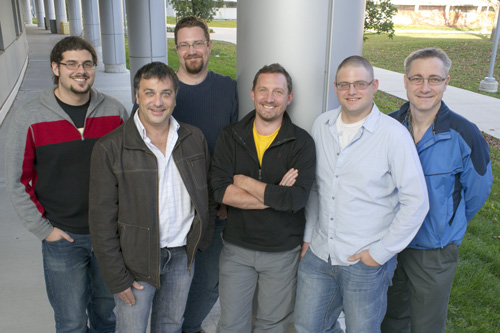
Think of ecology and you might picture the great outdoors. But a new cross-campus team is using the tools of ecologists – and those of philosophers and computer scientists – to look more closely inside DNA.
Spanning three colleges at U of G, the roughly year-old genome ecology working group hopes to learn more about how organisms’ genetic machinery is assembled and operated.
By focusing on large chunks of genetic material sometimes called “junk DNA,” they think they might ultimately help in understanding viruses and diseases, evolution and speciation, and cellular biology.
For now, they’re enjoying learning from each other during regular meetings, including finding a common language to speak across disciplinary borders. The group’s members are Prof. Stefan Kremer, director of the School of Computer Science; Profs. Ryan Gregory and Karl Cottenie, Integrative Biology; Prof. Stefan Linquist, Philosophy; and PhD students Brent Saylor and Tyler Elliott.
Referring to that scope, Kremer says, “That’s why I like hanging out with biologists – because I’m learning so much. I started out not knowing what a transposable element was.”
Transposable elements (TEs) – also called transposons or jumping genes – are stretches of DNA that move from one place to another in the genome. They were discovered in the 1940s by American corn geneticist Barbara McClintock, whose work with these genetic long-jumpers eventually earned her a Nobel Prize.
Transposable elements have often been described as genomic parasites because they use the cell’s genetic copying machine to replicate themselves.
They are known to make up about 45 per cent of the human genome. In most organisms with membrane-bound nuclei – including animals, plants and fungi – they are the largest component of non-coding DNA, or genetic material not involved in making proteins.
It’s still unclear how jumping genes affect organisms or even where they’ve come from. “Their biology is not well understood,” says Gregory. “Are they competing or co-existing with each other and with the rest of the genome?”
Some former transposons are believed to be now involved in epigenetics, regulating the expression of other genes. Other transposable elements have been co-opted to produce components of the immune systems of mammals, says Saylor. Elsewhere, TEs may cause mutations in the genome – sometimes leading to disease – depending on where they land and how effectively the cell suppresses them.
This fall, Saylor was among the first students to complete the master’s in bioinformatics degree program, launched at Guelph in 2009. Bioinformatics involves using computing, math and statistical tools to understand large volumes of biological data.
He studied TEs for his master’s project, co-supervised by Kremer and Gregory. Saylor has now begun a PhD co-supervised by Gregory, an evolutionary biologist, and Cottenie, a community ecologist.
Learning about TEs might also tell us something about viruses, including viral diseases. Inside cells, these elements copy and paste themselves into the genome in ways similar to viruses using cellular machinery to replicate themselves. Says Kremer, “If we understand how transposable elements formed, we might prevent future viruses and understand better where in DNA viruses hide.”
So what has genomics to do with ecology?
Community ecologists such as Cottenie look at numbers and distribution of species and their relationships in ecosystems. You can apply the same ideas to numbers and diversity of TEs and where they “live” in the environment of an organism’s genome – the main point of Saylor’s thesis, defended early this fall.
It’s more than a metaphor or analogy. TE populations are located along a linear DNA chromosome. Scientists can look at those population patterns like field ecologists observing changes in plant species moving from a field to a forest or from a valley to a mountaintop.
“So you can apply ecological principles and find meaningful results,” says Saylor. Using sequenced genomes for the fruit fly and the cow, he applied computing and statistical tools to look at spatial patterns of jumping genes.
In papers yet to be published, the researchers say they’ve distinguished between TEs’ ecological and evolutionary effects to explain some of those patterns. They found that ecological effects are greater in closely related species – say, species of fruit flies. But look instead at more widely varying relatives like diverse mammal species, and those ecological effects are swamped by broader evolutionary factors.
Says Cottenie, “If you look at mammals, the chance of picking up a signal through ecological processes is slim. Evolutionary processes are more likely to drive variation.”
With numerous copies of different TEs appearing throughout the genome, ecologists might regard them as ready-made experimental plots for running classic kinds of comparative studies.
Typically, community ecologists work with a “30 sites over 20 species” kind of model. Compare that to the huge amounts of data represented by omnipresent jumping genes.
“Here we have 50,000 sites along the chromosome and 500 types of transposable elements,” says Cottenie.
Adds Linquist, a philosopher of science: “Ecological models are hard to test. If transposable elements are an ecological system, we could use them for developing models and understand ecology without looking at ecosystems.”
Scientists elsewhere have discussed genome ecology. But the Guelph researchers say there’s confusion about terms and ideas. Much of the literature on genome ecology is less about ecology and more about evolution.
U of G’s group hopes to help establish some baselines for understanding and applying ideas in this new field. That includes Linquist, who co-teaches a graduate course in the philosophy of biology with Gregory.
Says Gregory: “Philosophers have skills in identifying assumptions, structuring arguments and clarifying concepts that scientists may or may not have.”
He and Prof. Terri Crease, Integrative Biology, co-supervised a master’s thesis by Elliott on a particular DNA transposon. For his PhD with Gregory, Elliott will study TE evolution, complementing Saylor’s work on TE ecology.
The new group spans the College of Arts, the College of Biological Science, and the College of Physical and Engineering Science. “This project has done a lot to get people together,” says Kremer.